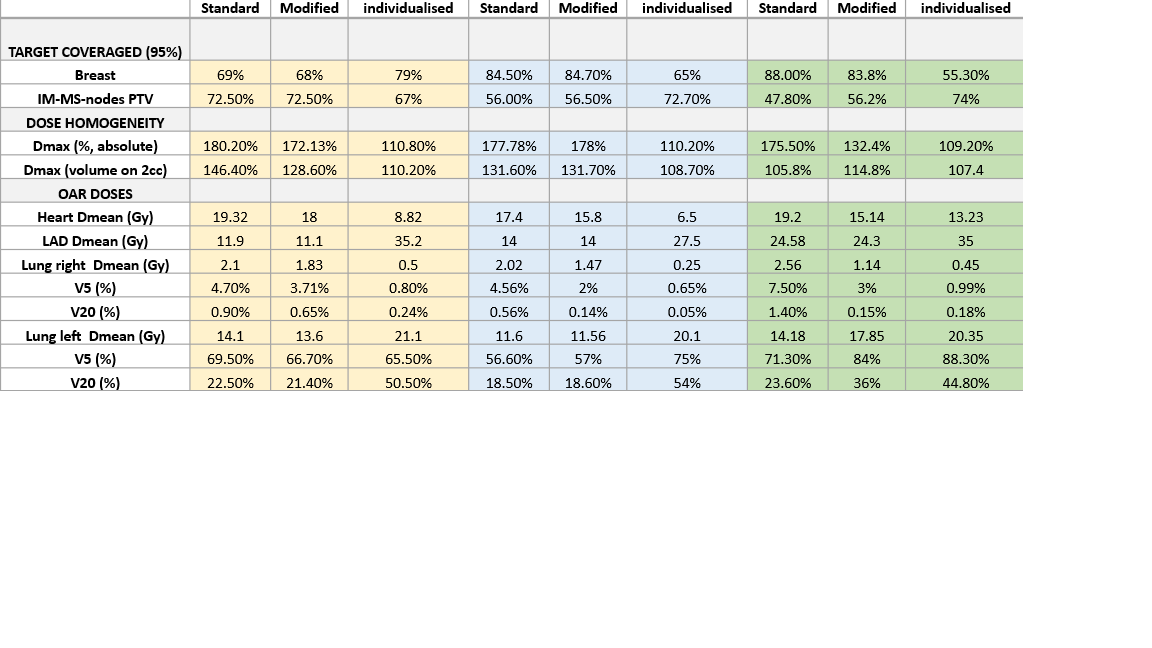Dosimetric analyses of 3 radiation techniques used in the EORTC 22922/10925 breast cancer trial
PO-2000
Abstract
Dosimetric analyses of 3 radiation techniques used in the EORTC 22922/10925 breast cancer trial
Authors: Orit Kaidar-Person1, Meytal Siman Tov2, Anna Ostrovski2, Laura Bogers3, Anna Petoukhova3, Sandra Hol4, Mirjam Mast5, Henk Struikmans6, Philip Poortmans7
1Sheba Medical Center, Breast Radiation Unit, Ramat Gan, Israel; 2Sheba Medical Center, Radiation Oncology, Ramat Gan, Israel; 3Haaglanden Medical Center, Department of Medical Physics, Leidschendam, The Netherlands; 4Institute Verbeeten, Radiation Oncology, Tilburg, The Netherlands; 5Haaglanden Medical Center, Research & Development, Leidschendam, The Netherlands; 6Leiden University Medical Centre, Radiation Oncology, Leiden , The Netherlands; 7Iridium Netwerk, Radiation Oncology, Wilrijk-Antwerp, Belgium
Show Affiliations
Hide Affiliations
Purpose or Objective
EORTC 22922/10925 trial, conducted between 1996 and 2004, aimed to evaluate the effect of internal mammary and medial supraclavicular lymph nodes (IM-MS) irradiation (RT) in stage I-III breast cancer patients. The trial allowed for 3 RT-techniques for IM-MS RT: standard, standard-modified, individualised. In our previous analysis we showed that these techniques varied in disease related outcomes and toxicity. The aim of the current study is to assess and compare the dosimetry of these 3 techniques and to correlate them to clinical outcomes of the trial using the robust treatment planning system available nowadays for dose calculation.
Material and Methods
Retrospective dosimetric analysis of anonymized data, therefore patient consent was waived. Ten cases of left breast/chest wall irradiation were randomly chosen for RT planning to a total dose of 50 Gy in 25 fractions. All cases were delineated by an expert radiation oncologist (HS). The treatment planning was done by a dosimetrist (AO) and a physicist (MS) according to the trial protocol and under close guidance of the EORTC 22922/10925 trial coordinators and members of EORTC radiation quality assurance team (RTQA). In short, the standard technique used a fixed set-up combining photon/electron beams to the IM and tangential fields to breast/chest wall; the standard-modified technique permitted minor adaptations for beam settings and the individualised technique allowed more freedom based on individual localisation of the IM. The full RT protocol and the outcomes are published before We present dosimetric parameters to the target volumes and organs at risk (OAR), mostly in % of the prescribed dose.
Results
Table 1 summarizes dosimetric parameters of 3 left breast cancer cases out of 10 that were planned according to the 3 RT techniques. Each colour represents one patient case. Target dose coverage differs between techniques for a single case and between patients. The dose to OARs varies per case and according to each technique. Mean heart dose was significantly higher in the standard and modified techniques (15-19 Gy) compared to individualised technique (6.5-13.3Gy), while the dose to the left anterior descending artery (LAD) was higher in the individualised technique. The differences in Dmax were up to 70% per case. Overall, the differences between the standard and modified standard techniques are relatively minor but significantly differ from the individualised technique (~30% differences in target coverage, ~70% in Dmax).
Conclusion
The 3 RT techniques used in the EORTC 22922/10925 trial varied in target coverage and OARs dose per patient case. The full report will include a dosimetric analysis of 10 cases planned according to the 3 RT techniques in correlation with the clinical outcomes of the trial reported per technique.